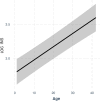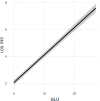The Seasonality of Serum Insulin Concentrations in Equids and the Association With Breed, Age, and Sex
- PMID: 40219807
- PMCID: PMC11992590
- DOI: 10.1111/jvim.70089
The Seasonality of Serum Insulin Concentrations in Equids and the Association With Breed, Age, and Sex
Abstract
Background: Current laboratory reference values for serum insulin concentrations do not account for seasonal fluctuations and differences associated with breed, sex, and age.
Hypothesis: We hypothesized that serum insulin concentrations would differ with the season, breed, sex, and age.
Animals: Laboratory records from 21 236 cases.
Methods: Cases were included where basal serum insulin concentration (INS) or serum insulin concentration after administration of Karo light syrup (INSpk) was measured, along with plasma glucose, breed, age, and sex. Multivariate analysis was used to investigate a seasonal effect on serum insulin concentrations, alongside the effect of breed, age, and sex.
Results: Basal serum insulin concentration in winter was significantly higher than in the other seasons (p < 0.001). Serum insulin concentration following administration of Karo light syrup in winter was significantly higher than in summer and fall (p < 0.001). The breed effect was assessed in the 9 most prevalent breeds and the donkey. Shetland ponies had significantly higher INS and INSpk than all breeds except Welsh ponies(p < 0.01). Welsh ponies had significantly higher INS than all other breeds except Shetland ponies (p < 0.01). Welsh ponies had significantly higher INSpk than all breeds (all p < 0.001), except Arabians, New Forest ponies, and Shetland ponies. Females had significantly higher INS than males (p < 0.001) and there was a positive and significant association between age and INS (est = 0.02; SE = 0.002, p < 0.001).
Conclusions: Insulin concentrations are influenced by season, breed, age, and sex. This information is essential for better understanding and management of insulin dysregulation.
Keywords: endocrine; equine; laboratory samples; season.
© 2025 The Author(s). Journal of Veterinary Internal Medicine published by Wiley Periodicals LLC on behalf of American College of Veterinary Internal Medicine.
Conflict of interest statement
The authors declare no conflicts of interest.
Figures





Similar articles
-
The effect of month and breed on plasma adrenocorticotropic hormone concentrations in equids.Vet J. 2022 Aug;286:105857. doi: 10.1016/j.tvjl.2022.105857. Epub 2022 Jul 5. Vet J. 2022. PMID: 35798232
-
The Effect of Season and Breed on Hypothalamic-Pituitary-Adrenal Axis Hormones, Metabolic Hormones, and Oxidative Markers in Ponies and Horses.J Vet Intern Med. 2025 Mar-Apr;39(2):e70047. doi: 10.1111/jvim.70047. J Vet Intern Med. 2025. PMID: 40048369 Free PMC article.
-
Investigation of breed differences in plasma adrenocorticotropic hormone concentrations among healthy horses and ponies.Vet J. 2023 Jun-Jul;296-297:105995. doi: 10.1016/j.tvjl.2023.105995. Epub 2023 May 18. Vet J. 2023. PMID: 37207985
-
Equine serum lipids: serum lipids and glucose in Morgan and Thoroughbred horses and Shetland ponies.Am J Vet Res. 1975 Dec;36(12):1705-8. Am J Vet Res. 1975. PMID: 1200441
-
BEVA primary care clinical guidelines: Diagnosis and management of equine pituitary pars intermedia dysfunction.Equine Vet J. 2024 Mar;56(2):220-242. doi: 10.1111/evj.14009. Epub 2023 Oct 5. Equine Vet J. 2024. PMID: 37795557 Review.
References
-
- Frank N., Bailey S., and Bertin F., Recommendations for the Diagnosis and Management of Equine Metabolic Syndrome (EMS) (Equine Endocrinology Group, 2022), https://equineendocrinologygroup.org/.
MeSH terms
Substances
LinkOut - more resources
Full Text Sources
Medical
Research Materials

